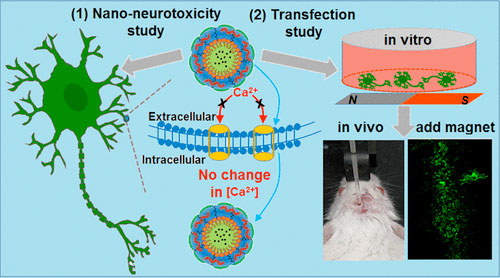| Oct 09, 2019 |
Novel nanoparticles reduce nanoneurotoxicity and enhance gene-transfection efficiency
|
|
(Nanowerk News) The research team led by Dr. WANG Zheng and Dr. QIU Zilong at the Center for Excellence in Brain Science and Intelligence Technology (Institute of Neuroscience) of the Chinese Academy of Sciences recently reported that PEGylation on the surface of positively charged magnetic poly(lactic-co-glycolic acid)-polyethylenimine (PLGA-PEI) nanoparticles reduced neurotoxicity, and this biocompatible nano-gene delivery vector also enhanced the transfection efficiency in primary hippocampal neurons under magnetofection condition.
|
|
The findings have been published in (ACS Applied Materials & Interfaces, "Effect of PEGylated Magnetic PLGA-PEI Nanoparticles on Primary Hippocampal Neurons: Reduced Nanoneurotoxicity and Enhanced Transfection Efficiency with Magnetofection").
|
 |
|
Safe and effective gene therapy is considered a promising strategy for regulating cell function and developing therapeutic treatments for brain diseases. However, it is challenging to transfect into the post-mitotic primary neurons because of restricted breakdown of the nuclear envelope.
|
|
Magnetic polymeric nanoparticles, MNP-PLGA-PEI, were developed for the utility of gene delivery. PEI with higher density of amino groups can be conjugated with negatively charged MNP-PLGA via electrostatic interaction to achieve positively charged nano-gene carrier. And, amphipathic PEG polymer with aldehyde groups can be modified on the surface of MNP-PLGA-PEI nanoparticles through Schiff base reaction to achieve PEGylated MNP-PLGA-PEI nanoparticles.
|
|
Through systematic evaluation, the researchers showed that PEGylation on the surface of MNP-PLGA-PEI nanoparticles with higher cellular uptake efficiency shielded the surface charge of MNP-PLGA-PEI nanoparticles and had lower neurotoxicity, thereby preventing perturbation of intracellular calcium homeostasis.
|
|
Furthermore, they found increased gene transfection efficiency in primary hippocampal neurons using PEGylated MNP-PLGA-PEI nanoparticles under an external magnetic field.
|

